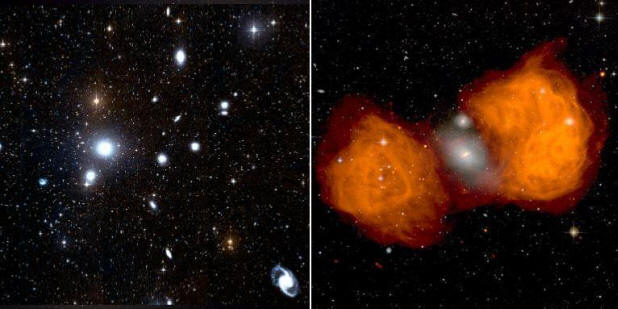
home •
about •
essential guide •
picture of the day •
thunderblogs •
news •
multimedia •
predictions •
products •
get involved •
contact
picture of the day archive subject index
Fornax A photographed in visible light (left center). Credit: Hubble Heritage
Radio telescope images reveal giant lobes of matter (right).
Credit: Ed Fomalont (NRAO) et al., VLA, NRAO, AUI, NSF
Jul 25, 2008
Empty Space Electric SpaceThis is the second Picture of the Day in a series that contrasts the vision of presently accepted theories with that of an Electric Universe.
The tiny oblong of light in the upper center of the image on the left is of a galaxy recorded in the wavelengths of electromagnetic radiation to which our biological visual apparatus responds. That apparatus is adapted to interpreting its signals in the context of conditions on the surface of the Earth. In consequence, other than the pinpoints of light that make up the galaxy, we assume that we see nothing because nothing is there.
This "default interpretation" of biological adaptation is a selection effect that biases our consideration of possible explanations. Because electromagnetic radiation can have wavelengths far outside the tiny range of human visual response, the visual data on which presently accepted theories are based constitutes a small and, as it turns out, unrepresentative sample.
We see an aggregation of matter. Because we see nothing nearby, gravity must be pulling the aggregation toward its center of mass. The theory of gravity dictates that energy and energy density must increase toward the center, and we see that this is true. Our "default" explanation has been verified.
But the space age introduced instruments that expanded our biological vision by detecting the other wavelengths. With our new "eyes," we saw that the empty spaces were laced with filaments and clouds of high-energy x-ray and gamma radiation. The entire sky was "fogged in" with low-energy microwave radiation. Where we saw darkness and emptiness at night, our new telescopes saw brightness and fullness and structure.
The image on the right is of the same galaxy recorded in radio wavelengths. Threads of radiation extend along the spin axis of the galaxy to fields of radiation far from the galaxy that are much larger than the galaxy. The Electric Universe sees this entire structure as a pinch in a cosmic Birkeland-current circuit. Induced secondary circuits generate rotation with spiral or ring structures in the equatorial plane and axial ejections with radio-noisy double layers at the boundary of the galactic sheath (magnetosphere).
So, is this "really" an electric galaxy instead of a gravity galaxy? Our biological default-interpretation apparatus has developed and has been refined over a long time. Our technologically enhanced sensors are recent, and we still "translate" their output into a bio-visual format that we inevitably interpret in some default manner. It's unlikely that first attempts at a new interpretation will be optimal adaptations to the new senses. The Electric Universe, as one of several new visions, provides useful contrast with the old to invigorate the neglected scientific question, What else could it be?
__________________________________________________________________________
Please visit our new "Thunderblog" page
Through the initiative of managing editor Dave Smith, weve begun the launch of a new
page called Thunderblog. Timely presentations of fact and opinion, with emphasis on
new discoveries and the explanatory power of the Electric Universe."The Electric Sky and The Electric Universe available now!

|
|

|
EXECUTIVE EDITORS:
David Talbott, Wallace Thornhill
MANAGING EDITORS:
Steve Smith, Mel Acheson
CONTRIBUTING EDITORS: Michael Armstrong, Dwardu Cardona,
Ev Cochrane,
C.J. Ransom, Don Scott, Rens van der Sluijs, Ian Tresman
WEBMASTER: Brian Talbott
Copyright 2007: thunderbolts.info
![]()
home
thunderblogs
forum
picture of the day
resources
team
updates
contact us

